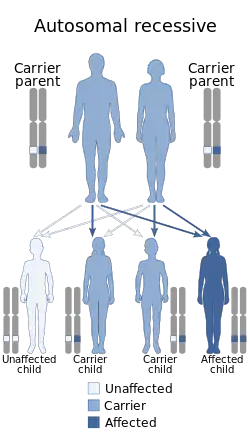| Spondylo-ocular syndrome | |
|---|---|
| Other names | SOS[1] |
 | |
| Spondylo-ocular syndrome is inherited in an autosomal recessive manner | |
| Specialty | Medical genetics |
Spondylo-ocular syndrome is a rare genetic disorder characterised by lesions in the eye and the spine.
Presentation
These can be divided into those affecting the eyes, spine and other areas:[2]
- Eyes
- Spine
- Other features
- facial dysmorphism
- facial hypotonia
- low posterior hairline
- short webbed neck
- low set ears
- mitral valve prolapse
- aortic valve malformation
- dilated ureters
- sensineural deafness
Genetics
This syndrome is caused by inactivating mutations in the xylosyltransferase (XYLT2) gene. It is inherited in an autosomal recessive manner.
Diagnosis
Treatment
History
This syndrome was first described by Schmidt et al in consanginous Iraqi family in 2001.[3]
References
- ↑ "OMIM Entry - # 605822 - SPONDYLOOCULAR SYNDROME; SOS". omim.org. Retrieved 25 June 2019.
- ↑ Munns CF, Fahiminiya S, Poudel N, Munteanu, MC, Majewski J, Sillence DO, Metcalf JP, Biggin A, Glorieux F, Fassier F, Rauch F, Hinsdale ME (2015)Homozygosity for frameshift mutations in XYLT2 result in a spondylo-ocular syndrome with bone fragility, cataracts, and hearing defects. Am J Hum Genet 96: 971-978
- ↑ Schmidt H, Rudolph G, Hergersberg M, Schneider K, Moradi S, Meitinger T (2001) Retinal detachment and cataract, facial dysmorphism, generalized osteoporosis, immobile spine and platyspondyly in a consanguineous kindred - a possible new syndrome. Clin Genet 59: 99-105
External links
This article is issued from Wikipedia. The text is licensed under Creative Commons - Attribution - Sharealike. Additional terms may apply for the media files.